Navy Vietnam War Elk Grove Village, IL Flight date: 05/15/24
By David Adams, Honor Flight Chicago Veteran Interview Volunteer
“‘First combat duty in the ship’s 21-year history.’ This was the way news accounts described the arrival of USS Franklin D. Roosevelt on Yankee Station, in the early morning hours of Aug. 10, 1966. Then, from Aug. 10 until Dec. 27, during several periods on the line in the Gulf of Tonkin, the FDR — as a part of the U. S. Seventh Fleet attack carrier striking force — hurled devastating air strikes against the North Vietnamese military machine.” Presidential, FDR’s monthly publication, “The War Cruise” issue, page 4.
Little did Chicago-born Thomas “Tom” William Davidson know, growing up in Cicero and Niles, that he would be an integral part of these FDR combat operations. He graduated from Maine High School in Park Ridge, now Maine East, with the class of 1964. He remembers that Hillary Rodham Clinton was in the class just behind him. Tom confesses that he was not suited for the college prep curriculum. Beginning in his junior year he enrolled in shop courses. His senior year, 1963-64, saw his participation in the work program, half a day at a job and half a day back in the classroom. His print shop teacher encouraged him to pursue the printing trade, which he did after his Navy enlistment was up in 1967.
Like most young men, high school graduation found him vulnerable for the draft. He passed his induction physical and then enlisted in the Navy. He said, “As a kid I always wanted to get in the Navy.” Mission accomplished. The Navy recruiter assured him that after two years of active duty he could serve the remainder of his six year obligation in the reserves. Ok with him.
Tom attended basic training, “boot camp”, at Naval Station Great Lakes. He remembers that his time at Great Lakes was “just a regular boot camp, nothing special’. His class spanned November 1965 to mid-January 1966, or about 2 months. Did Tom know exactly where he would be assigned after boot camp? He replies, “No, I knew that I would be an Airedale.” An Airedale, in Navy slang, is a sailor who works in one of the Navy’s aviation rates. His rate was Aviation Boatswain’s Mate (Launching & Recovery), ABE3. Tom was assigned to the aircraft carrier USS Franklin D. Roosevelt (CVA-42) docked at Mayport Naval Base, Florida, just outside Jacksonville. The carrier had earned the nickname the “Rosie”, among others.
He remembers that “when I got aboard the ship they told me what Division that I was going to go to because that’s where they needed me, period end of story”. He describes his first few weeks on board the Rosie: “Most guys [newly arriving on the carrier] went to ‘mess cooking’ for three months.” Duty in the mess is what you might think, washing dishes, mopping the deck, and doing whatever is otherwise necessary for operating the ship’s food service. But lucky for him, Tom had learned to type in high school. So he was assigned immediately to clerical duties in the Air Department Division V-2. V-2 is responsible for launching and recovery of aircraft. He worked clerical duties temporarily until permanently assigned to supply.
As a member of V-2, he “ran supply” most of the time. His “office” was right below the flight deck. Tom cross trained as an LSO, Landing Signal Officer, so he could function as such if needed. The LSO is responsible for the visual control of aircraft in the terminal phase of the approach immediately prior to landing. They communicate with landing pilots by voice radio and light signals. Tom spent considerable time on the LSO platform suspended from the side of the ship. Tom’s duties did not involve launching aircraft via the catapult, “cat”, or recovery where aircraft are brought to a full stop by catching arresting gear with a tailhook. However, he observed all during both day and night operations. Somehow he picked up the nickname “the twig” because he says he “topped the scales at 130 pounds”.
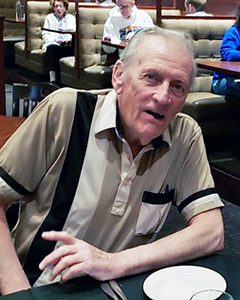
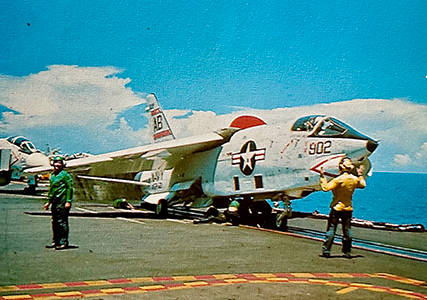
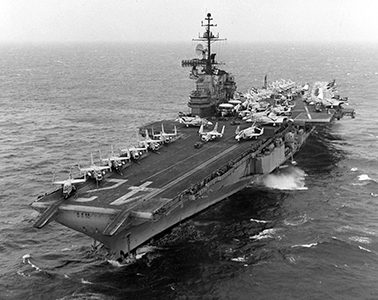
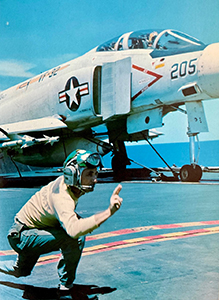
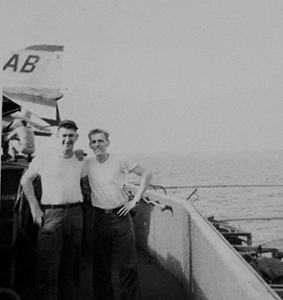
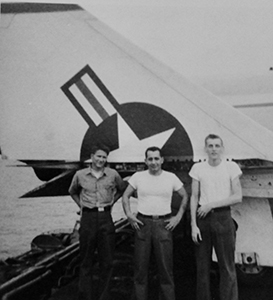
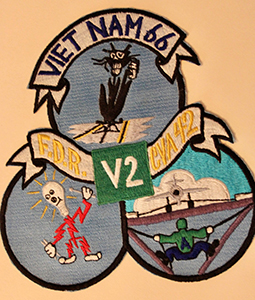
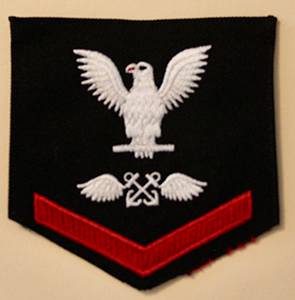
The Rosie principally served in the Mediterranean as a Sixth Fleet carrier. Due to the escalation of the war in Vietnam and the need for more air assets the carrier departed for its one and only West-Pac cruise on June 21, 1966. Tom remembers that the carrier’s full complement was 4,000 officers and men. Carrier Air Wing 1 included five fighter aircraft squadrons of A-4 Skyhawks and F-4 Phantom IIs plus other aircraft to support combat operations. Crossing the Equator, or “the line”, on July 4 about 3,700 souls were initiated into the silent mysteries of the deep. The Great Sea Lord, his Majesty Neptunus Rex, Ruler of the Raging Main and his Court presided. Tom says the Shellbacks, those men who had already crossed at some point in their careers, initiated the Pollywogs, those who had not, in the nearly day-long ceremony. The Shellbacks inflicted an imaginative variety of indignities upon their victims. The Pollywogs proudly emerged as Shellbacks and the carrier’s newsletter noted that they accomplished the rite “cleansed of all traces of city dust and country sod”.
After a stop in Rio De Janeiro the Rosie continued east rounding the Cape of Good Hope and sailed through the Indian Ocean. Tom recalls stopping in the Philippines at Subic Bay for final combat preparations before the carrier joined Task Force 77 in the Gulf of Tonkin on August 10. Combat operations began immediately. Daily sorties involved all fighter squadrons for a total of 24 Phantoms and 40 Skyhawks. The A-4 Skyhawk fighters were also called “Scooters”, because it looked like one, according to Tom.
He worked on the flight deck during launch and recovery of aircraft during combat operations. One of his duties was as a member of a team tasked to erect a barrier to stop returning aircraft in an emergency. This had to be done quickly and without error. Tom says working on Rosie’s flight deck was “one of the most dangerous jobs in the world.” Described another way, it was an “intricate choreography of man and machine working in unison to maintain the tempo of air operations essential for naval dominance in the Pacific theater.” FDR Naval History.
In particular Tom recalls seeing more than one fighter launch, disappear below the deck and emerge off the bow climbing skyward. More likely than not, he recalls, the pilot gave the catapult officer, or “Shooter”, an inaccurate, low, aircraft gross weight. Thus the cat would be programmed for the lighter weight and the aircraft would barely gain flying speed before leaving the carrier deck. He saw fighters descend toward the sea and, with the engines in full afterburner, kick up rooster tails from the water. No fighters were lost due to these rare circumstances, he is careful to say.
There were many losses during combat but he remembers one in particular. A-4 fighter pilot Lt. Alan Carpenter VA-72 was shot down in October, rescued at sea after bailing out, and returned to the carrier to fly again. Carpenter was shot down a second time on November 1. This time he was captured and interned in the Hanoi Hilton for over six years. Tom saw his televised return from imprisonment on March 4, 1973 during Operation Homecoming.
At the very end of Rosie’s West-Pac deployment, Bob Hope and his Christmas Show came aboard on December 27, 1966 to everyone’s enjoyment and obvious relief that the “war cruise” was at an end. All told the Rosie was “on the line” for 95 days and the Carrier Air Wing launched more than 7,000 combat sorties. Tom was an integral part of all of it.
Carrier maintenance required visits to Subic Bay and five days in Hong Kong. The Rosie departed for home from Subic Bay on January 18, 1967. Tom remembers that Rosie crossed “the line” again while transiting the Indian Ocean. 642 Pollywogs were initiated by the Shellbacks of which he was one this time. Back in Mayport the Rosie began preparation for its 17th Med cruise which would depart on August 24.
Even though his military obligation would be completed in November 1967, about 2 ½ months into the cruise, he could not convince the brass that he should revert to shore duty at Mayport. In retrospect Tom has no regrets finishing his Navy duty in the Mediterranean Sea. Approaching his November discharge date he left the Rosie in Naples, flew to Naval Station Rota, Spain then on to Naval Station Philadelphia for final out-processing. Although his two years of active duty were up, the Navy encouraged him to become a “fleet sailor”. Tom explains that his rate ABE3 had no “shore billets”. This meant that he would spend most of the next 18 years at sea. Tom rejected this “opportunity” and said he “was glad to get out.” He was released from active duty on November 8, 1967 having honorably served two years. He transferred to the inactive Naval Reserve for the next four years. Tom was awarded the Vietnam Service Medal, Republic of Vietnam Campaign Medal, and National Defense Service Medal.
Regarding his welcome home as a Vietnam veteran, Tom says he actually returned to the States twice, once at the end of the West-Pac “war cruise” and second during the Med cruise. At no time did he feel disrespected. “I did not [feel unwelcome] when I got home to Chicago and being that I was on an east coast carrier when I got back to Mayport I felt welcome.” His family and friends met him at O’Hare and a big party ensued.
On the West-Pac cruise he got hostile fire, “combat”, pay. Each payday, he sent his combat pay home via money order to be put aside to buy a car when he got out. According to plan, he recalls with pride, he bought a brand new 1967 Chevy Impala, “maroon with a white interior”. Although glad to be finished with his Navy service Tom stayed connected with some shipmates and over time others resurfaced. He says that “the friendships he made in those two years made it all worth it”.
Back in Illinois Tom found work as a printer for W. F. Hall Printing Co. famous for printing Playboy, National Geographic, Readers’ Digest, Montgomery Ward catalogs, and a multitude of other publications and paperback books. When the company closed he and a buddy opened their own printing business which they operated for about 19 years. After he sold the business he stayed on to work with the buyer. He retired from full time employment in 2008. For the last 13 years Tom has served as a crossing guard for the Elk Grove Village Police Department. Tom has served nine times as the commander of the VFW Niles Memorial Post 3579 to which he has belonged since 1977.
The VFW has been very good to him, he met his wife JoAnn there. Married in 1980, they will soon celebrate 44 years of marriage. They have two children and three grandchildren, a boy and two girls. Any “spare time” he has is reveling in the grandchildren and traveling.
Tom enjoy your well-earned Honor Flight to Washington and a third welcome home from the Vietnam War.


